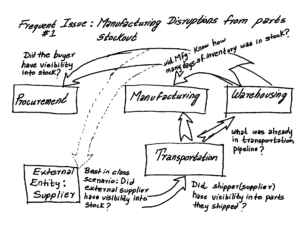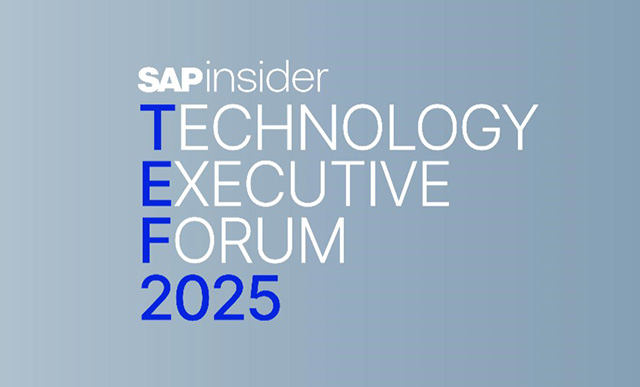Understanding the Key Aspect of Supply Chain Visibility
by Kumar Singh, Research Director, Automation & Analytics, Supply Chain Management, SAPinsider
Does your supply chain have true visibility ?
It is not a secret to any supply chain professional that in the world of supply chain, the more the information available on what is going on in the end-to-end supply chain, the more confident players in the chain can be about seamless execution. Common sense dictates that visibility leads to increased certainty and better control, and with that, the need for “just in case measures” like time buffers, labor buffers, inventory buffers etc. can be reduced significantly and considerable efficiencies can be derived. True visibility in supply chain can also take care of a demon that supply chain professionals have been trying to slay for a while- the bullwhip effect. Obviously there are numerous additional benefits of supply chain visibility, however a key question is- what should be considered true supply chain visibility ? If you do a deep dive into what visibility in supply chain world means, you will see many interpretations of it which may leave you with more questions like “What exactly is true supply chain visibility?”, rather than answers.
Explore related questions
There is no doubt in the fact that building an infrastructure that captures near real time data in your supply chain and business intelligence capabilities built on top of this data, form the foundation for supply chain visibility. But a key fact that also needs to be considered here is that these two together are not sufficient to build true supply chain visibility. Let us try to understand this with a simple example. Your organization is a manufacturing organization that has successfully built a solution that allows you to track movement for all shipments, across all modes, both inbound and outbound, throughout your supply chain. So here is the classic situation where you have millions of data points streaming your way, being collected on your servers, harmonized, wrangled, labeled and nicely arranged, sitting in databases. With this capability, you begin to get key insights, examples being what deliveries are running late, which are stuck at a hub etc. While I have laid out the definition of this capability in a rather simple way, to be fair, building this level of capability in itself is going to be a challenging and time consuming initiative. But the time and resources invested in this level are worth the effort, considering the significant advantages a strong foundation will yield in building the subsequent levels.
Now let us assume that you are able to build this capability. A question you may have at this point is- Why is the capability at this level not true visibility?
What exactly is true supply chain visibility?
Let us continue the shipping visibility example. You have your shipping data sitting in silo, with reporting capabilities. You are tracking your shipments based on certain aspects, like where they are in their journey and what is the expected delivery date. For example, every shipment needs to be moving, and expected to meet the expected delivery date. No Red flags if criteria like these are met. Why is this not true visibility? Well, because you are looking at the data in silo. What if you have a scenario where you had this inbound raw material product coming your way, and now your inventory availability for this raw material is running thin. There was some error that was rectified and now you realize that you need this raw material fast, in order to avoid a manufacturing disruption. The solution is common sense solution- see if there is any raw material in transportation pipeline that can be expedited. But only if you had received this view earlier. By the time you connect the dots, it may be too late to expedite anything. Disruption will be inevitable.
Hopefully, this example illustrated to you that while everything looked smooth in your information silo, it is the interconnectivity that provides you the visibility. If your inventory, manufacturing, transportation and other data elements are interconnected, you can create a reporting logic easily that can flag that with the current on hand inventory and the transportation expected delivery dates, your manufacturing may run into disruption. This example also illustrates why many organizations that have invested in a plethora of point systems, still run into disruptions that could have been avoided through true visibility.
Remember that the word “chain” in the term supply chain stems from the fact that supply chains are highly interconnected networks. Not only are different entities involved, but there are multiple functions within the same entity, increasing the complexity manyfold. These fragmentations mean fragmented data silos at entity level as well. And as the above example illustrates, these data silos are giving you localized visibility but when it comes to true supply chain visibility, you may not have it.
Why do organizations struggle to build true supply chain visibility?
A fundamental aspect of leveraging digital capabilities effectively in my perspective is to start by understanding what does an end objective mean in the real world. There may be numerous folks out there spearheading “digital transformation” initiatives who, if asked to explain what is the objective of the digital transformation in their specific initiative, without using a single technical jargon, will struggle. This same aspect happens in the case of supply chain visibility. Someone at the top passes a mandate- we need to build complete supply chain visibility. Everyone starts scrambling. “Experienced” individuals are hired from another company. They have to show some “good stuff” in first 90 days. Dashboards are built. New solutions are brought in. There are multiple leaders doing it for their respective functions.
Nothing is significantly off track in the approach till this point. As I mentioned earlier, this is foundational capability. The challenge is, majority of organizations that start, stop just short of building true visibility. These capabilities that get built in different silos, never integrate with each other in a way that creates true supply chain visibility, like the one in the example in the previous section. The result is that eventually, few years after the celebration of succesful implementation of these siloed initiatives, frustration starts building among the ranks of those who are supposed to leverage those solutions.
A solution will successfully deliver value when the end users of the solution see value in it and hence generate value from it. Due to these so called “visibility” silos, end users soon start running into scenarios where despite the visibility in their silo, something still breaks, blame cascades down to them, but there was nothing that they could have done with the “visibility” they had. Slowly, they stop relying on the solution. Within few years, the capability withers away. Point solutions are blamed. IT infrastructure is blamed.
Then a new person comes at the top. They say- we need to build complete supply chain visibility. And you know the drill !
So what is a good approach to start planning how to build true supply chain capabilities ?
Some organizations do realize where not to stop and a key priority for them is to integrate these point systems and data silos. And those are the ones that have been able to build true supply chain visibility. No – their success can not be attributed to another, new, fancy set of technologies, like control towers. Yes, control tower solutions promise exactly what true supply chain visibility should be. But at the end, it is a technology, and hence, an enabler. Stories of failed control tower initiatives abound. And because no one will say it, I will :The actual incidences of failures are at least twice as many as those publicly reported, based on my experience and conversations. Why ? Well, as a public company, if you have invested millions in a control tower initiative, and it does not provide that true capability, executives would rather celebrate the “success”, highlight the cosmetic wins, put some band-aids to make things work and move on. Afterall, after few years, everyone will be on their way to somewhere else, internally or externally, and a new set of executives will take over to solve the visibility problem for the nth time. Only those failures that have the magnitude level of “exploding in the face” become public news.
So how do you start ? While this may sound counterintuitive to today’s culture of throwing tech jargons and touting being “data driven” in every conversation- the first step may rather require that you be an artist who draws on a blank canvas. Well, not literally (in case you were panicking !). But what this means is that you need to forget about technology, and brainstorm, leveraging a blank slate approach. There are many ways I think about this, and the approach may differ from one company to another but here is one suggested approach, a simple three step process to kickstart your brainstorming.
- List all supply chain challenges that your organization normally runs into
- Brainstorm to understand which of those challenges can be attributed to lack of data visibility, despite the data being available within the org
- For the challenges/disruptions identified in second step, understand what the flow of data should have been
Whiteboard all the flows, in a simple form, like the example shown in the illustration below. And then eventually, create a “Master map” of flows from the brainstorming exercise.

You can see how those simple, three steps start creating a beautiful picture of the way your systems need to “talk” to each other ? And you are not even thinking about systems at this point. Now from this point onwards, you will start getting into the technology aspect. Understand what systems fall within each of the rectangles in your flow diagram. Understand their legacy aspects, their integration capabilities, can multiple legacy point systems be replaced by one off the shelf platform, what data integration technologies will be useful- the list of questions can be really long. But the good news is, when it comes to technology, there is a lot of resource available to get help.
So take a step back and be that fearless leader in your organization to challenge the thinking that the current siloed visibility is akin to supply chain visibility. Free your organization from the vicious cycle of going through the drill of building supply chain visibility capability every 5 years or so.
Kumar Singh, Research Director, Automation & Analytics, SAPinsider, can be reached at kumar.singh@wispubs.com








